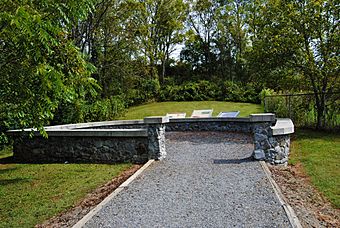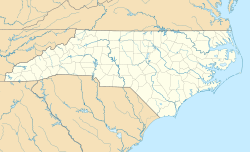Spikebuck Town Mound and Village Site facts for kids
Quick facts for kids |
|
|
Spikebuck Town Mound and Village Site
|
|
 |
|
| Location | Hayesville, North Carolina |
|---|---|
| Area | 145 acres (59 ha) |
| NRHP reference No. | 82003443 |
| Added to NRHP | August 17, 1982 |
The Spikebuck Town Mound and Village Site is a very old place in Hayesville, North Carolina. It's located near where Town Creek meets the Hiwassee River. This site was once home to a Cherokee village called Quanassee. The village was built around a large earth mound, known as Spikebuck Mound.
People started building this mound about 1,000 years ago. These were the ancestors of today's Native Americans, part of the South Appalachian Mississippian culture. Quanassee was known to early European settlers as one of the important Cherokee "Valley Towns."
The village was sadly destroyed in 1776 during the American Revolutionary War. This happened because the Cherokee were allies with the British at the time. Later, in the 1800s, most Cherokee people were forced to leave their homes in North Carolina. The Spikebuck Mound and village site became a protected archaeological site in 1982.
Contents
A Look Back: The History of Spikebuck Mound
Ancient Builders and Cherokee Life
People have lived along this river for more than a thousand years. It's believed that people from the South Appalachian Mississippian culture built the large earth mound. They also built a village around it. This shows how their society was organized.
Later, the historic Cherokee people settled here. They built their important communal building, called a townhouse, on top of the mound. This townhouse was a central place for the community. People gathered there for ceremonies and to discuss town matters. The townhouse would be rebuilt regularly, and the mound would also be maintained.
Quanassee: A Cherokee Valley Town
European settlers wrote about Quanassee as one of the Cherokee "Valley Towns." It was located along the Hiwassee River. A map from 1725 even shows it as Qunassee. The Cherokee lived here from the 1600s into the 1800s.
During the American Revolutionary War, the Cherokee supported the British. Because of this, American rebels attacked and damaged Quanassee in 1776. In the late 1830s, the United States government forced the Cherokee to give up their land here. Many people were gathered in this area before being forced to move west. This difficult journey is known as the Trail of Tears.
Learning from the Past: Discoveries at Spikebuck Mound
Early Finds and Excavations
For many years, the mound and village areas were owned by European Americans. They used the land for farming, which changed the top layers of soil.
In 1961, the first official excavation happened. A researcher named Frank Osborne found a fire pit in the village area. He also found the outline of an oval-shaped house. This oval shape was typical for Cherokee homes from the late 1600s to mid-1700s. Before that, they usually built square or rectangular houses.
More Discoveries and European Connections
In 1973 and 1975, a team from Western Carolina University did more digging. They found artifacts that were even older, dating back to 3,000 B.C. They also found items from 1,000 A.D., when the earth mound was likely built. The team found proof of a palisade, which was a fence-like wall, that went around the Cherokee town.
They also found historic Cherokee items and European goods. These European items show that the Cherokee traded with colonists. In total, they found house patterns, fire pits, trade goods, storage pits, and different types of pottery, pipes, and beads. These finds show that the Cherokee traded with Europeans. They also show that the Cherokee were part of large Native American trading networks across North America.
The archaeological site was officially listed as "Spikebuck Town Mound and Village Site" in 1982. This listing helps protect the site.
Protecting the Site Today
In 2000, Clay County bought the part of the site with the mound. They are now protecting it. The county built a special viewing area near the mound. A park called Veterans Recreational Park was also built nearby in downtown Hayesville.
Other groups are also working to preserve Cherokee history in Hayesville. The Clay County Communities Revitalization Association (CCRA) has created the Quanassee Path. This path highlights five important Cherokee spots near Hayesville. They also have the Cherokee Homestead Exhibit. This exhibit shows reconstructed traditional Cherokee homes and a corn storage building. There is also a Cherokee Botanical Sanctuary.
The Archeological Conservancy bought the former Cherokee town and farmstead site in 2011. They are working to protect it. They believe the site is very important for research. They have allowed Western Carolina University to continue archaeological field schools there. Students use special technology called remote sensing. This helps them find possible structures without digging. By 2016, the team found a large feature, which was likely a house.



